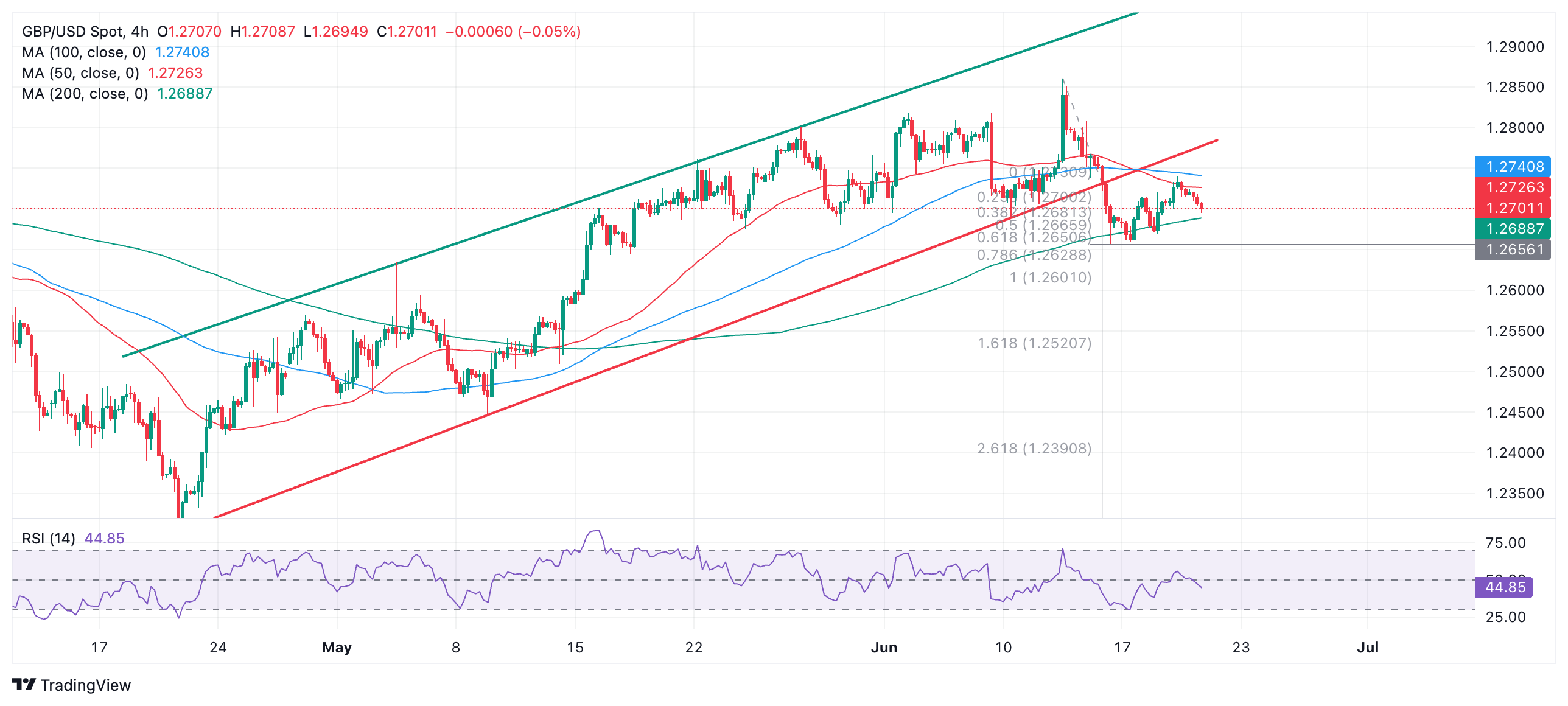Pound Sterling extends losses after BoE meeting

- The Pound Sterling prints red bars on traders’ screens after the Bank of England meeting.
- The bank leaves interest rates unchanged and keeps the same 7-2 split in voting.
- The language of the accompany statement and minutes tilts marginally dovish weighing on GBP.
- Recent inflation data was mixed despite the headline rate hitting the BoE’s 2.0% target.
The Pound Sterling (GBP) trades a quarter of a percent lower on Thursday in the 1.2680s against the US Dollar (USD), after the Bank of England (BoE) policy meeting, a key event for GBP pairs.
Pound Sterling weakens after BoE decision
The Pound Sterling continues falling after the BoE publishes its policy decision on Thursday. The BoE, which sets interest rates in the UK, left its policy intererst rate unchanged at 5.25% at the meeting. The decision was agreed by a vote of 7 for a hold, and 2 for a cut, the same as the previous meeting.
The accompanying statement, however, said the decision was “finely balanced” suggesting there had been a fair risk the BoE would cut rates instead.
The BoE mentioned the August decision and how new information “affects the assessment that the risks from inflation persistence are receding”, which was a hint the bank could be planning to cut interest rates in August, according to Yohay Elam, Product Manager at FXStreet.
Higher interest rates tend to appreciate the Pound by attracting more foreign capital inflows; the opposite is true of lower interest rates. The decisions of the BoE, therefore, heavily impact the Pound.
Downside for the Pound Sterling is likely to remain capped, however, by the BoE’s inflation forecast for H2 which it sees rising up to 2.5% YoY.
The decison was in line with the market consensus which was for no rate cuts and a 7-2 split in the voting, with 2 favoring a cut. It is very rare for the BoE to change interest rates during an election campaign. BoE Governor Andrew Bailey himself said a rate cut at the meeting could be, “neither ruled out nor a fait accompli”.
Despite UK Consumer Price Index (CPI) inflation data showing a fall to the BoE’s 2.0% target in May, higher inflation in other pockets of the economy continue to keep policymakers wary of cutting, with a first rate cut not likely until August.
“Over in the UK, there was another important milestone yesterday, as CPI inflation fell exactly in line with the Bank of England’s target, reaching +2.0% in May as expected,” says Jim Reid, Global Head of Macro Research at Deutsche Bank. “However, some of the details of the report were less favorable, as core CPI was higher at +3.5%, while services inflation surprised on the upside at +5.7% (vs. +5.5% expected), and that’s one of the stickier categories. As a result, investors dialed back the chance that the Bank of England would cut rates by the August meeting, with the chance falling from 52% to 34% by the close.”
On Thursday morning, Swiss Franc traders were handed some volatility to play with after the Swiss National Bank (SNB) decided to cut interest rates for the second time in a row to 1.25%. The decision, however, was widely expected, with two-thirds of economists polled by Reuters prior to the event saying they thought the SNB would cut. Still, the SNB decision does not particularly serve as an accurate barometer of what to expect from the BoE.
Technical Analysis: Pound Sterling lacks direction after breakdown runs out of steam
GBP/USD is pulling back after breaking below the (red) lower trendline of a rising channel. From a technical perspective, the trend in the short-term is unclear and the pair could either break lower or just as well recover.
GBP/USD Daily Chart
The sharp decline which saw GBP/USD break out of the bottom of the channel could be a sign the short-term trend is reversing. However, the lack of follow-through lower after the break cautions traders against getting too bearish.
A break below the 1.2657 level (June 14 low) would provide more evidence of a change to a more bearish short-term trend, with an initial target coming in at 1.2601, the extension of the height of the move prior to the break below the channel, extrapolated lower.
On the other hand, a break above the 100 Simple Moving Average (SMA) at 1.2740 could indicate the resumption of the prior uptrending bias, with a target at the underside of the channel at circa 1.2775.
Economic Indicator
BoE Interest Rate Decision
The Bank of England (BoE) announces its interest rate decision at the end of its eight scheduled meetings per year. If the BoE is hawkish about the inflationary outlook of the economy and raises interest rates it is usually bullish for the Pound Sterling (GBP). Likewise, if the BoE adopts a dovish view on the UK economy and keeps interest rates unchanged, or cuts them, it is seen as bearish for GBP.
Last release: Thu Jun 20, 2024 11:00
Frequency: Irregular
Actual: 5.25%
Consensus: 5.25%
Previous: 5.25%
Source: Bank of England
